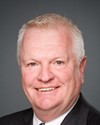I do, actually.
Over the last 50 years, have we increased dramatically the amount of track we have in Canada?
Evidence of meeting #7 for Transport, Infrastructure and Communities in the 39th Parliament, 2nd session. (The original version is on Parliament’s site, as are the minutes.) The winning word was track.
A recording is available from Parliament.
Conservative

Brian Jean Conservative Fort McMurray—Athabasca, AB
I do, actually.
Over the last 50 years, have we increased dramatically the amount of track we have in Canada?
Conservative

Brian Jean Conservative Fort McMurray—Athabasca, AB
In fact, isn't it the case that we've actually eliminated some of the track?
Director General, Rail Safety, Department of Transport
Some were eliminated; some were transferred from the class 1 railways to short lines. This is a number that is available, which we can provide to you as well.
Conservative

Brian Jean Conservative Fort McMurray—Athabasca, AB
Have we increased the amount of stock, the number of engines and cars?
Director General, Rail Safety, Department of Transport
I'd say, from my knowledge, that cars that are Canadian property have gone down in the past few years, probably from 105,000 to about 97,000. However, that is not reflective of what is being used in Canada, because many of the cars are provided by car leasers.
Conservative

Brian Jean Conservative Fort McMurray—Athabasca, AB
Is it also fair to say that the technology on the newer machines is much safer than the technology on the old machines?
Director General, Rail Safety, Department of Transport
Yes. For instance, 4.3 million cars were being loaded in Canada in 2006, and that number increases slightly every year.
Conservative

Brian Jean Conservative Fort McMurray—Athabasca, AB
So we have better machines and better technology, we have more inspections done by machines, which are more accurate, and we have fewer lines and less stock, and more inspectors?
Conservative

Brian Jean Conservative Fort McMurray—Athabasca, AB
The last question I have for you is in relation to crossings themselves. My understanding is that it costs about $200,000 to $300,000 to put up one of the light crossings. Is that correct?
Director General, Rail Safety, Department of Transport
That's the grade crossing improvement program. Yes.
Conservative

Brian Jean Conservative Fort McMurray—Athabasca, AB
Is this the only way? Is there some sort of technology available between zero cost and $250,000?
I have a huge rural constituency with a tremendous number of crossings, to be honest, and I have a lot of complaints from my constituents. How do we get those crossings that are currently not governed by these flashing lights and gates...? Is there some sort of technology or safety device that we could utilize that would be less expensive and just as intrusive?
Director General, Rail Safety, Department of Transport
There are all sorts of things: stop signs, advance warning, synchronization between street lights and the crossing. But if the crossing is not protected.... There's not much between being protected and not being protected, other than an advance warning letting you know that there will be a crossing after that curve. Other than that, there's not much.
Assistant Deputy Minister, Safety and Security, Department of Transport
We also have another contribution program to close crossings. We really encourage people to come forward and propose closure of crossings and closure of the road, when that's possible, because it also improves safety to have fewer crossings.
December 11th, 2007 / 10:40 a.m.
Conservative

Brian Jean Conservative Fort McMurray—Athabasca, AB
I know I'm out of time, Mr. Chair, but can I just ask how much money those advance warnings cost?
Conservative

Brian Jean Conservative Fort McMurray—Athabasca, AB
Thank you, sir.
How much does it cost for those advance lights?
Director General, Rail Safety, Department of Transport
It's just a sign, so I don't know—a few hundred bucks.
Conservative
Director General, Rail Safety, Department of Transport
It's not a signal; it's a sign.
Conservative

The Chair Conservative Merv Tweed
I have Mr. Bell and Mr. Fast, but I have one question.
Can you give me an example of where you would close a road?
Assistant Deputy Minister, Safety and Security, Department of Transport
Some crossings are no longer used. These are mostly abandoned. Some roads are no longer used, and there's a new road not too far away from it. Rather than leaving such crossings open, which is an indication—remotely, but there are still accidents—we'd rather close them. We have a contribution program within which we give money to close those.